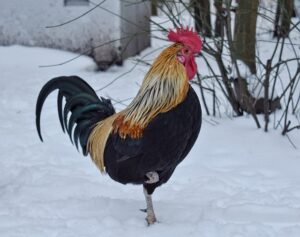Ask any backyard homesteader or poultry farmer, and they’ll tell you—chicken predator protection is a full-time job. Whether you’re a first-time chicken owner or an experienced keeper, there’s nothing quite as heartbreaking as discovering a breach in your coop or a missing bird. Chickens are gentle, inquisitive creatures, but unfortunately, the world is filled with predators that see your feathered friends as an easy target.
Don’t panic! With the right knowledge, equipment, and planning, you can ensure your flock stays safe, happy, and healthy. This guide dives deep into everything you need to know about chicken predator protection and coop security.
I. Understanding Predators
The first step to protecting your chickens is knowing what kind of predators you’re up against. Not all threats look the same, and each has its unique “skillset.”
A. Common Predator Types
- Ground Predators like foxes, raccoons, dogs, and coyotes are experts at digging and breaking into unsecured coops. Their love for nighttime mischief makes them particularly sneaky.
- Aerial Predators such as hawks, owls, and eagles strike from above. Have you seen a majestic bird of prey circling your yard? It’s not admiring your landscaping.
- Small Predators like weasels, rats, and snakes may not look intimidating, but they can squeeze through the tiniest spaces to wreck your day—and your eggs.
B. Predator Identification
If tragedy does strike, don’t just throw your hands up in despair. Learn to play detective!
- Look for tracks near the coop. Are they paw prints? Claw marks? Small slithering trails?
- Observe the signs of the attack. Missing heads? Scattered feathers? Empty eggs? Each predator has its MO (modus operandi).
- Pay attention to patterns—did it happen in the night? During the day? Some predators are nocturnal, while others are active at dawn and dusk.
C. Risk Assessment
Your geography, local predator species, and even the time of year can affect what kind of threats your chickens face. Winter landscapes might bring hungry coyotes closer, while a warm spring might encourage snakes.
II. Physical Security Measures
A. Building a Bulletproof Coop
- Foundation Security: Dig down and bury hardware cloth around the base of the coop—at least 12 inches deep. It’s like putting a “No Digging” sign for predators.
- Wall Integrity: Use sturdy materials. Yes, plywood is great for DIY projects, but predators think of it as an appetizer.
- Roof Security: Predators don’t just come from the ground. Cover your coop with solid roofing or strong hardware cloth to keep aerial threats out.
- Doors & Windows: Reinforce EVERY access point. Raccoons are basically furry locksmiths—they can open simple latches if they’re not secure.
B. Securing the Chicken Run
- Install anti-dig measures, such as buried fencing or pavers around the perimeter.
- Cover the top of the run with netting or hardware cloth to guard against aerial attacks.
- Double-check gates and perimeter security. Remember, even a small gap is an open invitation.
C. Hardware Matters
Repeat after me: chicken wire is NOT predator-proof. Invest in hardware cloth (19-gauge or thicker), solid locks, and weather-resistant materials that will last for years.
III. Active Security Systems
A. Lights
Motion-activated lights can scare off predators before they even get a chance to investigate. Plus, solar-powered options are easy to install and eco-friendly.
B. High-Tech Solutions
From automatic door closures to surveillance cameras, modern technology makes it easier than ever to monitor and protect your flock. And for those who like to sleep soundly, try predator alarms equipped with motion sensors to alert you to any nighttime visits.
IV. Natural Deterrents
A. Livestock Guardian Animals
Dogs, geese, and even donkeys? You bet! Livestock guardian animals can be highly effective against predators. A well-trained dog or a particularly sassy goose (yes, geese are underestimated warriors) can keep your chickens safe and even add some personality to your property.
B. Environment Management
- Landscaping Modifications: Clear tall weeds and bushes around the coop to eliminate hiding spots.
- Barrier Plants like thorny shrubs can make it tricky (and painful) for predators to get close.
V. Security Protocols
A. Daily Routines
- Inspect the coop every morning and evening.
- Count your chickens (yes, literally). A quick headcount ensures no one’s missing.
- Lock up religiously every night. Seriously, don’t skip this step.
B. Regular Maintenance
- Weekly checks can catch small vulnerabilities before they turn into major breaches.
- Upgrade and repair materials seasonally to keep pace with weather damage or wear and tear.
VI. Emergency Response
Despite your best efforts, sometimes predators get in. Stay calm and follow this plan:
- Immediate Actions: Check on the remaining flock and secure the area.
- Provide first aid to any injured chickens and consult a vet if necessary.
- Document the attack—this helps identify patterns or weaknesses in security.
VII. Special Considerations
A. Free Range Management
Free-ranging chickens are at higher risk, but supervised outings and creating “safe zones” (using movable fencing, for example) can minimize danger. Another option might be a chicken tunnel. Also having multiple bushes and trees your birds can shelter under increases free range safety.
B. Lock-Up & Night Security
Nighttime is when the most attacks happen. Install supplementary lighting or deterrents around the coop perimeter if you’re in a high-risk area.
VIII. Budget-Friendly Tips
A. DIY on a Dime
- Recycle materials like pallets for coop walls.
- Make scarecrow-style predator deterrents—it’s the arts and crafts project your chickens didn’t know they needed.
IX. Documentation Matters
Keeping a security log can help you track predator patterns, schedule maintenance, and respond more effectively down the road. Have emergency contacts saved, like local animal control or fellow chicken keepers who can offer advice.
Final Thoughts
Think about it this way: predator-proofing your coop is less an expense and more an investment. Every measure you take ensures your flock stays safe, your mornings stay peaceful, and your egg count stays high.
Still have questions about coop safety? Drop them in the comments below! And if you’re ready to build the ultimate chicken fortress, check out our resources for tools and materials. Happy homesteading! 🐔✨

